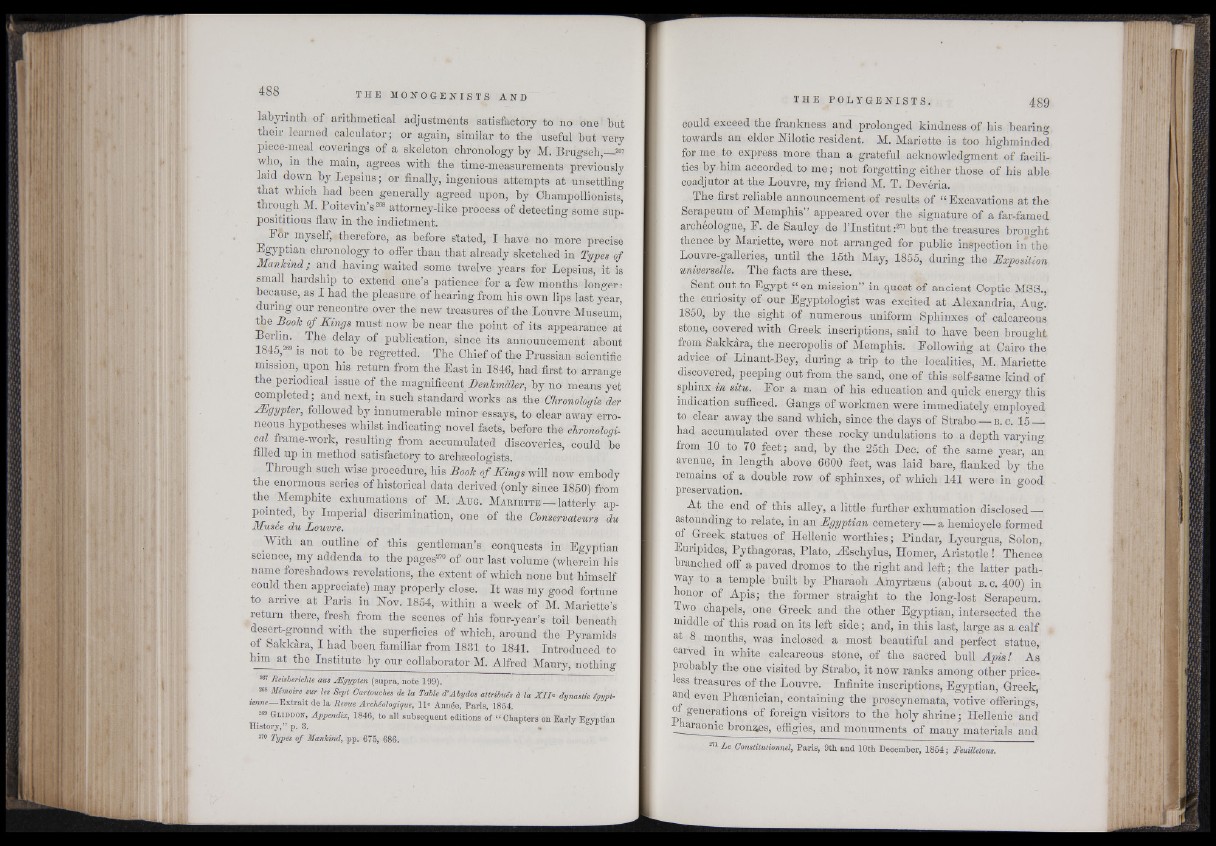
labyrinth of arithmetical adjustments satisfactory to no one' but
their learned calculator; or again, similar to the useful but very
piece-meal coverings of a skeleton chronology by M. Brugsch, 267
who, in the main, agrees with the time-measurements previously
laid down by Lepsius ; or finally, ingenious attempts at unsettling
that which had been generally agreed upon, by Champollionists,
through M. Poitevin’s268 attorney-like process of detecting some supposititious
flaw in the indictment.
Eor myself,- therefore, as before stated, I have no more precise
Egyptian chronology to offer than that already sketched in Types of
Mankind ; and having waited some twelve years for Lepsius, it is
small hardship to extend one’s patience for a few months^ longer:
because, as I had the pleasure of hearing from his own lips last year,
during our rencontre over the new treasures of the Louvre Museum,
J e Book of Kings must now be near the point of its appearance at
Berlin. J The delay of publication, since its announcement about
1845,269 is not to be regretted. The Chief of the Prussian-scientific
mission, upon his return from thé East in 1846, had first to arrange
the periodical issue of the magnificent Denkmäler, by no means yet
completed ; and next, in such standard works as the Chronologie der
Ægypter, followed by innumerable minor essays, to clear away erroneous
hypotheses whilst indicating novel facts, before the chronological
frame-work, resulting from accumulated discoveries, could be
filled up in method satisfactory to archseologists.
Through such wise procedure, his Book of Kings will now embody
the enormous series of historical data derived (only since 1850) from
the Memphite exhumations of M. Aug. Mariette — latterly appointed,
by Imperial discrimination, one of the Conservateurs du
Musée du Louvre.
With an outline of this gentleman’s conquests in Egyptian
science, my addenda to the pages™ of our last Volume (wherein his
name foreshadows revelations, the extent of which none but himself
could then appreciate) may properly close. It was my good fortune
to arrive at Paris in Nov. 1854, within a week of M. Mariette’s
return there, fresh from the scenes of his four-year’s toil beneath
desert-ground with the superficies of which, around the Pyramids
of Sakkàra, I had been familiar from 1831 to 1841. Introduced to
him at the Institute by our collaborator M. Alfred Maury, nothing
267 Reisberichte aus Ægypten (supra, note 199).
268 Mémoire sur les Sept Cartouches de la Table d’Abydos attribués à la XII* dynastie égyptienne—
Extrait de la Revue Archéologique, 11« Année, Paris, 1854.
269 G iid d o n , Appendix, 1846, to all subsequent editions of “ Chapters on Earlv Egyptian
History,” p. 3. *
270 Types of Mankind, pp. 675, 686.
could exceed the frankness and prolonged kindness of his bearing
towards an elder Hilo tic resident. M. Mariette is too highminded
for me to express more than a grateful acknowledgment of facilities
by him accorded to me ; not forgetting either those of his able
coadjutor at the Louvre, my friend M. T. Devéria.
The first reliable announcement of results of “ Excavations at the
Serapeum of Memphis” appeared over the signature of a far-famed
archéologue, P. de Saulcy de l’Institut:271 but the treasures brought
thence by Mariette, were not arranged for public inspection in the
Louvre-galleries, until the 15th May, 1855, during the Exposition
universelle. The facts are these.
Sent out to Egypt “ en mission” in quest of ancient Coptic MSS.,
the curiosity of our Egyptologist was excited at Alexandria, Aug!
1850, by the sight of numerous uniform Sphinxes of calcareous
stone, covered with Greek inscriptions, said to have been brought
fiom Sakkara, the necropolis of Memphis. Eollowing at Cairo the
advice of Linant-Bey, during a trip to the localities, M. Mariette
discovered, peeping out from the sand, one of this .self-same kind of
sphinx in situ. Eor a man of his education and quick energy this
indication sufficed. Gangs of workmen were immediately employed
to clear away the sand which, since the days of Strabo^b. c . 15 —
had accumulated over these rocky undulations to a depth varying
fiom 10 to 70 feet; and, by the 25th Dec. of the same year, an
avenue, in length above 6600 feet, was laid bare, flanked by the
remains of a double row of sphinxes, of which 141 were in good
preservation.
At the end of this alley, a little further exhumation disclosed —
astounding to relate, in an Egyptian cemetery — a hemicycle formed
of Greek statues of Hellenic worthies; Pindar, Lycurgus, Solon,.
Euripides, Pythagoras, Plato, -Æschylus, Homer, Aristotle! Thence
branched off a paved dromos to the right and left; the latter pathway
to a temple built by Pharaoh Amyrtæus (about b . o. 400) in
honor of Apis; the former straight to the long-lost Serapeum.
Two chapels, one Greek and the other Egyptian, intersected the
middle of this road on its left side ; and, in this last, large as a calf
at 8 months, was inclosed a most beautiful and perfect statue,
carved in white calcareous stone, of the sacred bull Apis! As
probably the one visited by Strabp, it now ranks among other price-,
ess treasures of the Louvre. Infinite inscriptions, Egyptian, Greek,
an even Phoenician, containing the proseynemata, votive offerings,
or generations of foreign visitors to the holy shrine; Hellenic and
- araonic bronzes, effigies, and monuments of many materials and
m Le Constitutionnel, Paris, 9th and 10th December, 1854; Feuilletons.